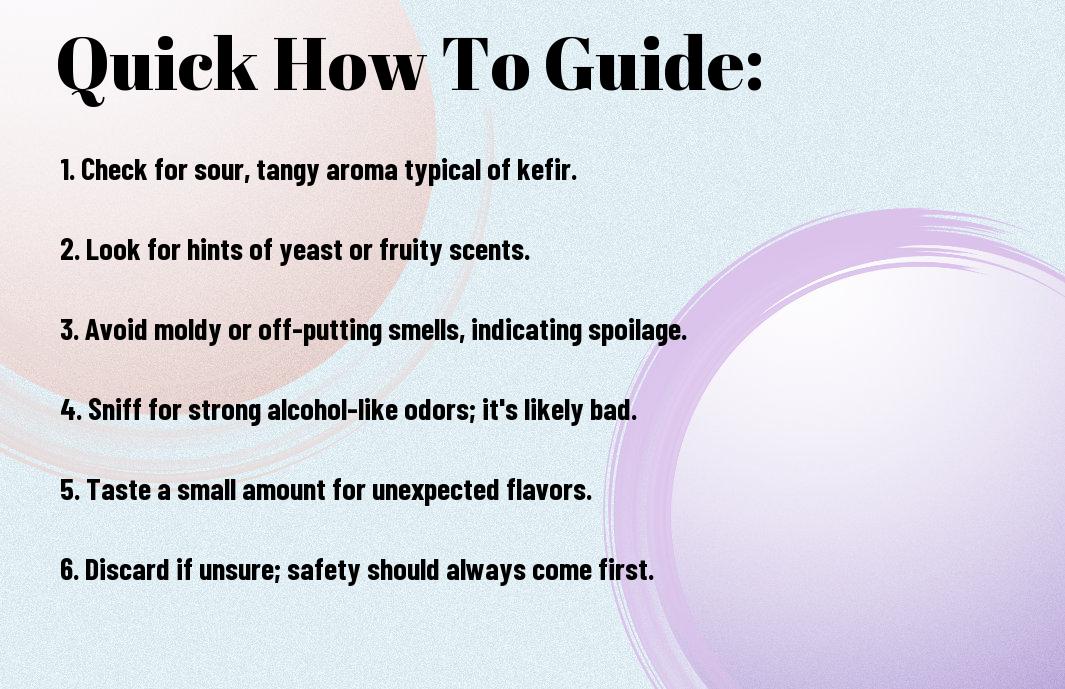You might wonder what your kefir should smell like and how to determine if it’s still safe to consume. A pleasant, slightly tangy aroma is typical for fresh kefir, while an off-putting or foul smell indicates spoilage. Knowing the difference is vital for your health, as consuming spoiled kefir can lead to unpleasant foodborne illnesses. In this guide, you’ll learn how to identify the signs of good kefir and when it’s time to dispose of it for your safety.
Key Takeaways:
- Kefir should have a pleasantly tangy and slightly yeasty aroma, which indicates that fermentation is taking place correctly.
- If kefir develops an off-putting or rancid smell, it is a sign that it may have gone bad and should not be consumed.
- An unusual odor may also accompany changes in texture or color, which further suggests that the kefir is no longer safe to drink.

Understanding Kefir Smell
Before you examine enjoying your kefir, it’s vital to understand how the smell plays a role in its freshness and safety. Kefir is a live culture beverage, and its aroma can reveal a lot about its current state. By recognizing the normal kefir scent and identifying any off-putting odors, you can ensure that you’re consuming a good product and avoid any unpleasant surprises.
Normal Kefir Aroma
Kefir typically has a fresh, tangy, and slightly yeasty aroma. You might observe hints of milkiness, reminiscent of yogurt or buttermilk, due to the fermentation process. This pleasant scent indicates that your kefir is still fresh and full of beneficial probiotics, ready for you to enjoy as part of your healthy lifestyle.
Off-Putting Odors
One of the key indicators that your kefir has gone bad is the presence of off-putting odors. A strong, foul, or unpleasant smell can signal spoilage, which you should not ignore.
Plus, if you notice a smell resembling rotten eggs, rancid butter, or any overwhelming sourness, it’s a clear sign of fermentation gone wrong. Such odors may indicate harmful bacterial growth that could lead to foodborne illnesses. You should avoid consuming kefir that has these unpleasant smells, as they indicate that the product is no longer safe for your health. Trust your senses—if it doesn’t smell right, it’s best to discard the kefir and get a fresh batch.

How to Assess Kefir Freshness
There’s no need to guess whether your kefir is fresh. By using a few simple techniques, you can easily determine its quality and safety for consumption. Observing the aroma, visual cues, and texture will allow you to enjoy kefir at its best and avoid any potential health risks.
Visual Inspection
The first step in assessing your kefir’s freshness is to examine its appearance. Look for any signs of separation, an unusual color, or the presence of mold. Fresh kefir should be creamy and slightly thick, with a pale, off-white color. If you notice any deviations from this, it’s best to err on the side of caution.
Texture and Consistency
You should also pay attention to the texture and consistency of your kefir. Fresh kefir typically has a smooth, creamy mouthfeel, without any clumps or abnormal lumps. If you find that the kefir has become excessively watery or has an uneven texture, it may indicate spoilage.
Texture is a significant aspect of determining kefir freshness. Fresh kefir should have a thick, creamy consistency that comes from the fermentation process. If you notice that your kefir appears runny, clumpy, or grainy, it’s advisable to discard it. Additionally, if there are any signs of separation beyond what is typical, such as a significant watery layer on top, this may suggest spoilage. Always trust your senses and prioritize your health when enjoying kefir.

Tips for Storing Kefir
Many people overlook proper storage techniques for kefir, but it’s crucial for maintaining its freshness and flavor. Consider these tips for optimal storage:
- Always use an airtight container to minimize exposure to air.
- Keep your kefir refrigerated at a temperature below 40°F (4°C).
- Avoid sunlight and heat sources that can accelerate spoilage.
- Store kefir away from strong odors, as it can absorb them easily.
This will help ensure your kefir remains delicious and safe to consume.
Ideal Storage Conditions
One of the best ways to keep your kefir fresh is to store it in a clean, airtight container in the refrigerator. This helps to maintain the proper temperature and limits exposure to bacteria and mold, ensuring that your kefir retains its delicious tangy flavor and probiotic benefits.
Expiration Dates and Best-By Guidelines
Ideal conditions for kefir storage also involve paying attention to expiration dates and best-by guidelines. These dates are typically found on store-bought kefir, indicating when it’s expected to retain its best flavor and quality. After the best-by date, your kefir may still be safe to consume if it has been stored properly, but the flavor might diminish.
The expiration date on kefir is a good indication of freshness, but it’s important to trust your senses. If the kefir is approximately one to two weeks past its expiration date, you should inspect it carefully. Look for any signs of separation, off-smells, or unusual coloration. If you notice any sign that it might be spoiled, it’s best to err on the side of caution and dispose of it to avoid any potential health risks associated with consuming spoiled dairy products.
Factors Affecting Kefir Quality
Once again, several factors can influence the quality of your kefir. These include:
- Ingredients used
- Fermentation time
- Storage conditions
Thou should monitor these elements closely to ensure that your kefir remains fresh and safe for consumption.
Ingredients Used
To make high-quality kefir, you need to pay attention to the ingredients used in the process. The type of milk or non-dairy substitute you choose plays a significant role in the final taste and texture of your kefir. Fresh and organic options usually yield better results, ensuring that you get the healthiest live cultures.
Fermentation Time
Ingredients and their respective fermentation time are critical for ensuring the quality of your kefir. Long fermentation can sometimes lead to a sour taste, but it’s important for the development of beneficial probiotics. You can generally ferment kefir between 12 to 48 hours depending on temperature and desired tartness. Too short of a fermentation can result in a less potent kefir, while over-fermentation can lead to separation and undesirable sourness.
Used properly, fermentation time ensures that your kefir is rich in nutrients and contains the right level of probiotics. Monitor your kefir closely during this period, as over-fermentation can spoil the taste and quality, making it unpleasant to consume. A gentle approach during the fermentation process will yield a delicious and nutritious product that you can enjoy.
Common Kefir Spoilage Signs
Now that you know what kefir should smell like, it’s important to be aware of common spoilage signs. These indicators can help you determine whether your kefir is still safe to consume. Keep an eye out for unexpected changes in smell, appearance, or texture, which can signal that your kefir has gone bad and should not be consumed to avoid any health risks.
Bacterial Contamination
There’s a possibility of bacterial contamination in your kefir if you notice an off-putting smell or sour taste that differs significantly from its usual tang. This can occur if the fermentation process is disrupted or if proper storage practices are neglected, leading to an imbalance in the probiotic cultures.
Mold Development
Common signs of mold development include fuzzy patches or discoloration on the surface of your kefir. Mold can appear green, black, or white and can pose serious health risks. If you observe any mold, it is best to discard the kefir immediately to avoid potential contamination and illness.
To prevent mold development, store your kefir in a clean, airtight container and refrigerate it promptly after fermentation. If you see any signs of mold, it signals that harmful fungi may have invaded your kefir, making it unsafe to consume. Be cautious and prioritize your health—it’s better to err on the side of safety and discard any questionable kefir.
How to Use Kefir Safely
To ensure you preserve the quality and health benefits of kefir, handle it with care. Store your kefir in a cool environment, ideally in the refrigerator, to minimize bacterial growth. Always check the expiration date and look for signs of spoilage, such as off odors or changes in texture. When enjoying kefir, make sure to use clean utensils and avoid cross-contamination for maximum safety.
Culinary Uses
On a culinary level, kefir is a versatile ingredient that can enhance your meals. Use it in smoothies, salad dressings, and marinades for a tangy flavor while adding beneficial probiotics. It also serves as a great substitute for buttermilk or yogurt in baking recipes, boosting the nutritional profile of your favorite dishes.
Incorporating into Diet
Assuming you want to integrate kefir into your everyday meals, start with small quantities to see how your body responds. This can help avoid potential digestive discomfort. Experiment with kefir beverages in your breakfast routine, or add it to snacks such as dips or spreads.
Incorporating kefir into your diet can significantly enhance your overall health. Its high probiotic content supports gut health, improves digestion, and boosts your immune system. Start by adding just a few tablespoons each day, gradually increasing to one cup as your body adjusts. Be mindful of any possible lactose intolerance symptoms, as some individuals may experience discomfort. By listening to your body and adapting as needed, you can enjoy the numerous benefits kefir has to offer in a safe and delicious manner.
Summing up
Hence, understanding what kefir should smell like and how to determine its freshness is important for enjoying its health benefits. Fresh kefir has a tangy, slightly yeasty aroma, while a sour or off-putting scent indicates it may be spoiled. Always trust your senses; if it looks, smells, or tastes unusual, it’s best to err on the side of caution and discard it. By keeping these guidelines in mind, you can ensure that your kefir remains a nutritious and enjoyable addition to your diet.
FAQ
Q: What is the typical smell of fresh kefir?
A: Fresh kefir usually has a pleasant, slightly tangy aroma, resembling yogurt or buttermilk but with a more complex, fermented scent. It may also have a mild, yeasty smell that reflects the fermentation process. This fresh aroma is a good indication that it has been properly fermented and is still safe to consume.
Q: What does kefir smell like when it is spoiled?
A: Spoiled kefir often emits an off smell that can be sour in a negative way, resembling spoiled milk. It may have a putrid or rancid odor that is very different from the normal tangy scent of fresh kefir. If you notice any unpleasant or foul smells coming from the kefir, it is best to discard it to avoid any potential health risks.
Q: How can I tell if my kefir has gone bad without smelling it?
A: Aside from smell, you can check the texture and appearance of your kefir. If it has developed an unusual color, such as pink, green, or any off-color, or if you see any mold on the surface, it is best to throw it away. Additionally, if the kefir has become excessively thick or has separated into curds and whey in an unusual manner, it may be a sign that it is no longer good.
Q: Can the smell of kefir vary between batches?
A: Yes, the smell of kefir can vary between batches due to factors like the milk used, the fermentation duration, and the specific kefir grains employed. Different strains of bacteria and yeast present in the kefir culture can also contribute to variations in aroma. However, regardless of these variations, the smell should always remain pleasant and tangy rather than offensive or sour.
Q: How should I store kefir to maintain its smell and quality?
A: To maintain the quality and aroma of kefir, store it in an airtight container in the refrigerator. This will slow down fermentation and help prevent spoilage. It is also important to keep it away from strong-smelling foods in the fridge, as it can absorb odors. Consuming kefir within 1-2 weeks of making or purchasing it is recommended to ensure optimal freshness.
